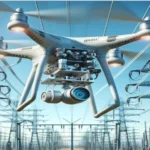In recent years, the logistics and delivery industry has undergone a massive transformation, driven largely by technological advancements. One of the most exciting innovations is the rise of delivery drones. These unmanned aerial vehicles (UAVs) are set to change the way goods are transported, offering faster, more efficient, and environmentally friendly solutions for the delivery sector. In this article, we will explore how delivery drones are revolutionizing the logistics industry and what the future holds for this game-changing technology.
What Are Delivery Drones?
Delivery drones are unmanned aerial vehicles designed to carry packages and deliver them to customers without human intervention. They use electric power and are equipped with various sensors, cameras, and GPS systems to navigate through the air and reach their destinations.
Delivery drones come in various sizes, from small drones that can carry lightweight packages to larger drones capable of handling heavier loads. These drones feature automated flight control systems that allow them to fly efficiently, avoid obstacles, and land safely at the delivery point. The ability to automate the entire delivery process makes drones a revolutionary force in the logistics industry.
Why Are Delivery Drones Gaining Popularity?
The logistics industry has long relied on trucks, vans, and human drivers to deliver goods. While these methods are effective, they come with several limitations, including traffic congestion, high fuel consumption, and slow delivery times. Delivery drones offer a solution to many of these problems, providing several advantages over traditional delivery methods.
- Speed and Efficiency
Delivery drones can deliver packages faster than conventional methods. Drones fly directly from the distribution center to the delivery location, bypassing traffic congestion and reducing delivery time. This speed is particularly beneficial for same-day or time-sensitive deliveries, allowing companies to meet customer demands more effectively. - Cost-Effectiveness
Delivery drones reduce operational costs in several ways. They eliminate the need for a large fleet of delivery trucks, which are expensive to maintain and fuel. Additionally, drones automate the delivery process, reducing labor costs and increasing efficiency. These savings make drones a cost-effective solution for logistics companies. - Environmental Impact
The logistics industry is a major contributor to global carbon emissions, with delivery trucks being one of the primary sources of pollution. Delivery drones are electric-powered, producing zero emissions during flight. By switching to drone-based delivery systems, companies reduce their carbon footprint and contribute to a more sustainable future. This shift aligns with the growing demand for eco-friendly alternatives. - Access to Remote Areas
Drones can access hard-to-reach locations that may be difficult for traditional delivery vehicles to reach. Rural areas or islands without proper road infrastructure can benefit from drone deliveries, as drones fly directly to their destinations without needing to navigate through traffic or complex terrain. This capability opens new markets for delivery services and ensures that remote customers receive the same level of service as urban customers.
Key Industries Benefiting from Delivery Drones
Delivery drones have the potential to transform a wide range of industries. Here are some key sectors benefiting from drone technology:
1. E-Commerce and Retail
E-commerce is one of the biggest beneficiaries of delivery drones. With the rise of online shopping, customers demand faster delivery options. Companies like Amazon are already testing drone-based delivery systems for Prime customers. These drones promise to shorten delivery windows and help companies meet customer demands more quickly.
Smaller e-commerce businesses also use drones for local deliveries, giving them a competitive edge by offering faster service. With drones, retailers no longer depend on third-party courier services, leading to a more seamless and cost-effective process.
2. Healthcare and Pharmaceuticals
In the healthcare sector, delivery drones transport medical supplies, medicines, and even organs for transplant. Drones deliver life-saving medications quickly, especially in emergencies, without the delays caused by traffic or road closures. Some countries already test drones for delivering medical goods to remote hospitals or clinics, improving medical logistics and ensuring critical supplies are available when needed.
Drones also transport blood, vaccines, and other time-sensitive medical materials, reducing the time it takes to move supplies and improving efficiency in healthcare systems.
3. Food Delivery
The food delivery industry also benefits from drones. While food delivery services have traditionally relied on cars, motorcycles, and bicycles, drones offer faster and more efficient deliveries. Companies like Uber Eats and DoorDash are exploring drone delivery models, particularly in densely populated urban areas where traffic can slow down traditional delivery methods.
By using drones, food delivery services can reduce delivery times, ensure food freshness, and lower operational costs.
4. Postal and Courier Services
Traditional postal and courier services increasingly use drones in their operations. Drones carry smaller packages, letters, and parcels, reducing the need for large delivery trucks. This leads to faster deliveries, especially for standard mail items. In some regions, drones already deliver parcels to customers’ doorsteps, marking the beginning of a significant shift in the logistics industry.
Challenges of Delivery Drones
While delivery drones offer numerous advantages, several challenges remain before widespread adoption becomes a reality:
- Regulatory Hurdles
One major obstacle is the regulatory environment. Governments worldwide are still working on creating clear guidelines for the safe use of drones in commercial deliveries. Issues like airspace management, flight paths, and safety protocols need addressing to ensure drones can operate safely and efficiently. - Privacy and Security Concerns
The use of drones for deliveries raises privacy and security concerns. Drones may navigate residential areas, leading to potential issues with surveillance and data collection. Additionally, the risk of drones being hijacked or hacked is a concern for both companies and customers. - Limited Payload Capacity
While drones work well for small, lightweight packages, they are still limited by their payload capacity. Large items, such as furniture or electronics, are not suitable for drone delivery at this stage. However, advancements in drone technology may lead to larger drones capable of carrying heavier loads in the future.
The Future of Delivery Drones
Despite the challenges, the future of delivery drones looks promising. As technology improves, drones will become more efficient, reliable, and capable of handling larger payloads. In the coming years, more businesses will adopt drone delivery systems, especially in urban areas for last-mile deliveries. The logistics industry will continue to innovate, integrating drones into the supply chain and transforming the delivery experience for consumers worldwide.
Conclusion
Delivery drones are poised to revolutionize the logistics industry by offering faster, more efficient, and cost-effective delivery solutions. With their ability to bypass traffic, reduce environmental impact, and access remote areas, drones are already transforming various industries, from e-commerce to healthcare. While challenges remain, the continued development of drone technology and evolving regulations will pave the way for widespread adoption, making delivery drones a key component of the future of logistics.




